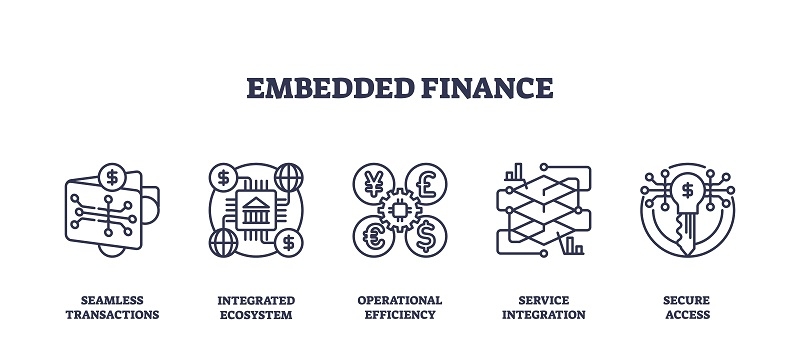
In the remaining decade, embedded finance has converted the manner Americans interact with cash. From paying for groceries with an app to getting a loan while buying online, finance is being woven seamlessly into our normal digital lives. Today, finance embedded in U.S. Apps makes it viable to revel in banking services—without ever stepping into a bank.
You’ve in all likelihood used embedded finance already without realizing it. Whether it's splitting a ride fare, getting approved for buy-now-pay-later structures, or incomes cashback through a store’s app, you’re interacting with economic services delivered at once interior non-financial apps. In this guide, we’ll discover how embedded finance works, what its topics are, and the way it’s changing the face of banking throughout the United States.
Embedded finance refers to the mixing of economic services into non-financial platforms. In easy terms, it lets in businesses like e-trade stores, rideshare apps, and online marketplaces to offer banking-like functions without being banks themselves.
Instead of redirecting users to traditional banks, companies use embedded finance API examples to plug services like payments, lending, coverage, or even funding products right into their virtual enjoy. This lets purchasers do things like:
It’s rapid, invisible, and becoming increasingly more important in the USA’s virtual economy.
Let’s break down how finance embedded in U.S. Apps is delivered. The mystery lies in APIs—software programming interfaces—which permit economic services to be included in non-economic structures.
With those APIs, companies can provide financial tools interior their apps, making transactions clean and intuitive for customers throughout the USA.
One of the most successful programs of embedded finance is through buy-now-pay-later platforms (BNPL). These systems allow purchasers to make purchases now and pay in installments, regularly without interest.
Popular BNPL vendors like Affirm, Klarna, and Afterpay accomplice with online shops to offer installment payments at checkout. Here's how embedded finance powers the system:
The comfort and pace of BNPL are made feasible by embedded finance APIs, remodeling how Americans save online.
Another mighty use is embedded lending for stores. Shops can effortlessly offer corporate or patron financing by way of integrating loan selections into their online or point-of-sale structures.
In these cases, outlets don't act as banks; however, through embedded finance, they provide capital in real-time. This model facilitates small companies to improve their business with hassle-free bank office work—a major win for entrepreneurs within the USA.
Another modern use case is banking in experience-hail apps like Uber and Lyft. These businesses provide monetary offerings to their drivers, permitting them to:
Drivers don’t want to apply for a separate bank or financial app. Through embedded finance APIs, the trip-hailing platform itself turns into a financial hub. This is in particular important in the USA, where gig work has end up a main source of income for millions.
Embedded finance brings monetary get admission to to gig workers who may not have traditional banking get entry to, imparting quicker, more inclusive economic offerings right in which they work.

For U.S. Consumers, embedded finance unlocks:
The advantages are equally strong for businesses integrating money into their applications:
In the USA, increasing economic growth through embedded finance can stimulate genuine business growth, regardless of whether you are a merchant, platform issuer, or app developer.
Industry analysts estimate that embedded finance may want to generate over $230 billion in annual sales by way of 2025 in the U.S. On my own. It’s greater than a trend—it’s a financial revolution.
As customer expectancies grow and guidelines evolve, organizations across the us are investing in embedded finance infrastructure to live aggressively.
While the advantages are clear, there are challenges to embedding finance into non-economic apps:
The momentum in the back of embedded finance is irresistible in spite of those boundaries. The comfort and personalization it offers are too powerful to disregard.
When using apps with financial skills, bear the following in mind:
The world of embedded finance is right here, and it’s thriving in the USA. From finance embedded in U.S. Apps to banking in ride-hail apps, this innovation is making monetary equipment greater handy, inclusive, and consumer-pleasant than ever earlier than.
As a patron, you benefit from seamless offerings, quicker get entry to to finances, and improved economic inclusion. As an enterprise or developer, you can achieve deeper engagement, increased revenue, and greater manipulate over the customer enjoy.
Whether you’re using purchase-now-pay-later platforms, exploring embedded lending for stores, or simply paying your rideshare driver, embedded finance is already part of your regular life. And it’s simplest going to grow.
This content was created by AI